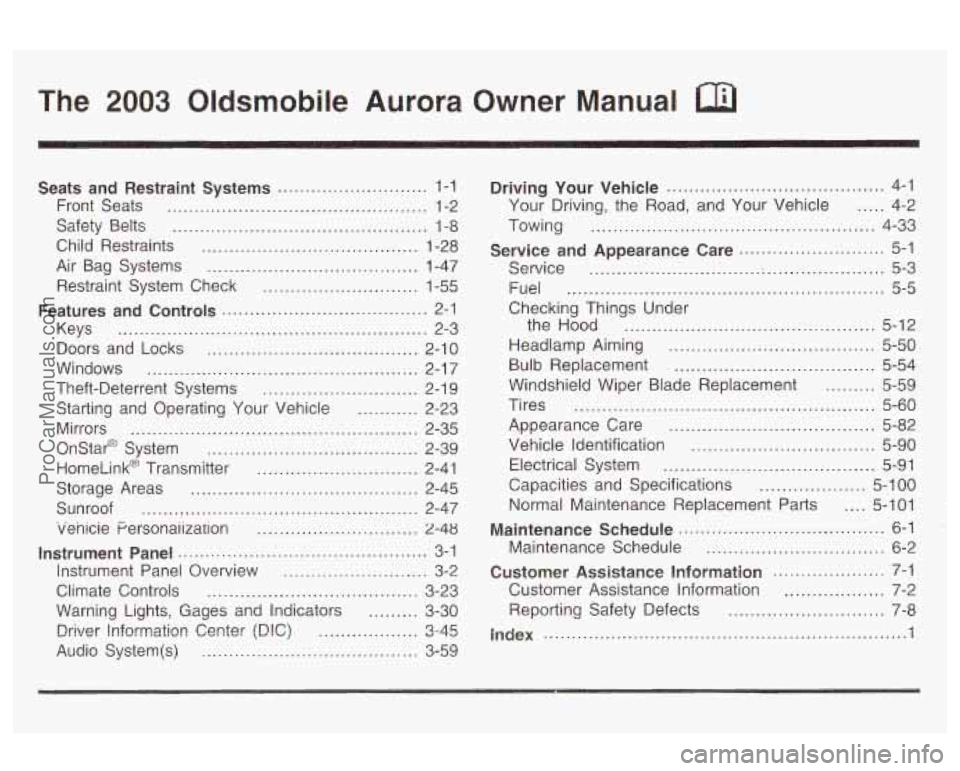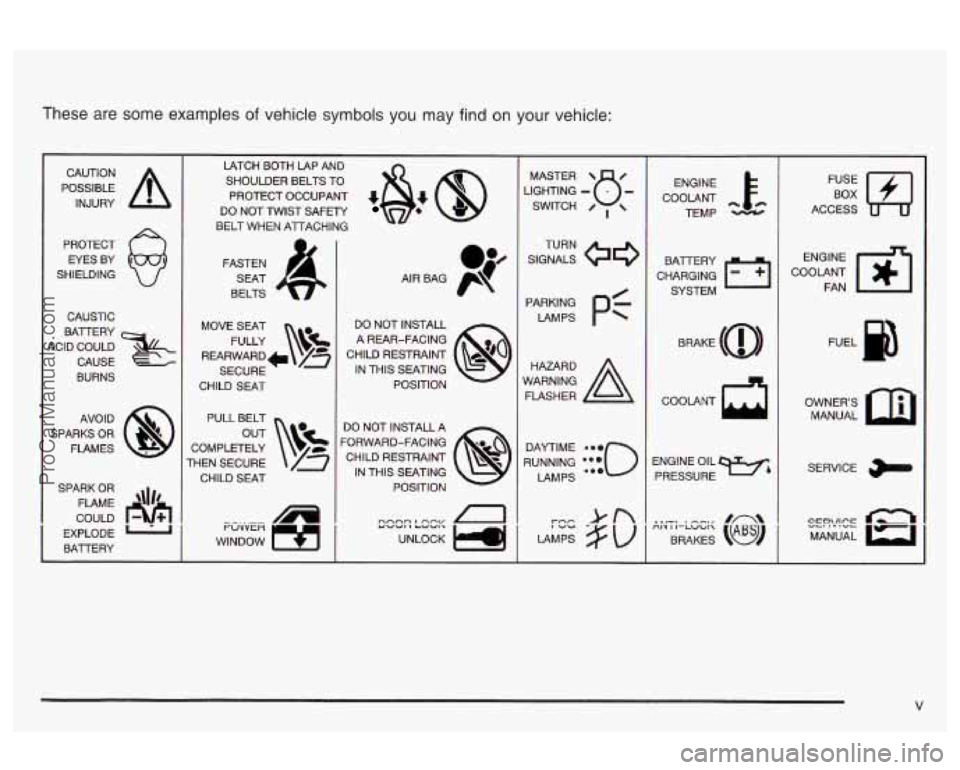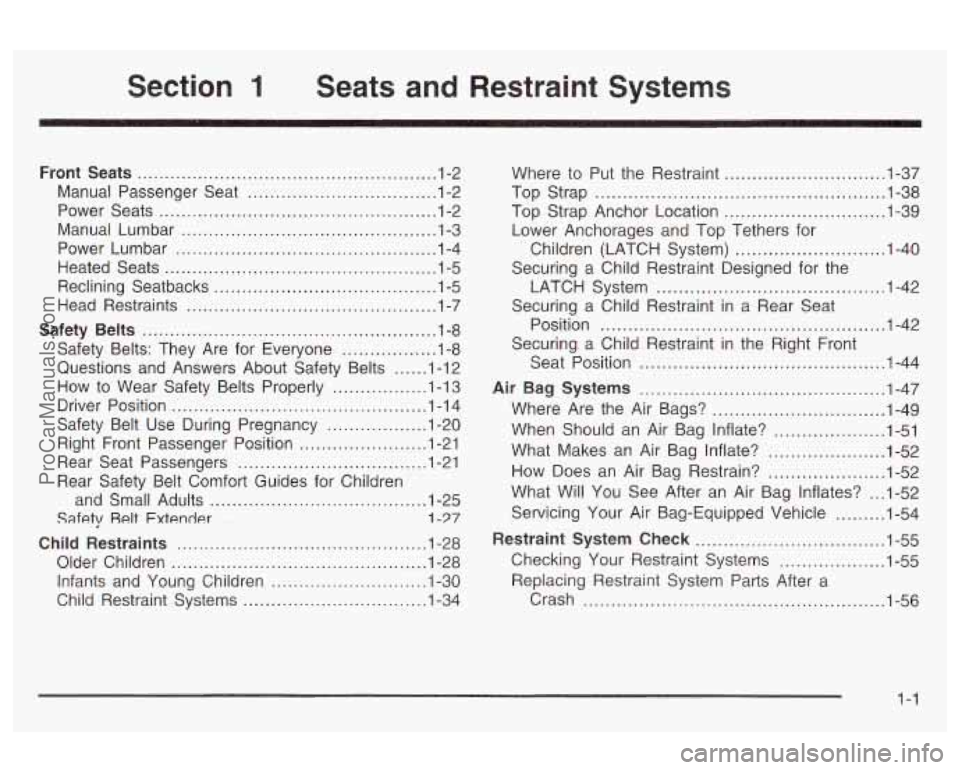child restraint OLDSMOBILE AURORA 2003 Owners Manual
[x] Cancel search | Manufacturer: OLDSMOBILE, Model Year: 2003, Model line: AURORA, Model: OLDSMOBILE AURORA 2003Pages: 387, PDF Size: 18.05 MB
Page 2 of 387

The 2003 Oldsmobile Aurora Owner Manual
Seats and Restraint Systems ........................... 1-1
Front Seats
............................................... 1-2
Safety Belts
.............................................. 4 -8
Child Restraints
....................................... 1-28
Air Bag Systems
...................................... 1-47
Restraint System Check
............................ 1-55
Features and Controls ..................................... 2-1
Keys
........................................................ 2-3
Doors and Locks
...................................... 2-10
Windows
................................................. 2-1 7
Theft-Deterrent Systems ............................ 2-1 9
Starting and Operating Your Vehicle
........... 2-23
Mirrors
.................................................... 2-35
Onstar@ System
...................................... 2-39
HomeLink@ Transmitter
............................. 2-41
Storage Areas
......................................... 2-45
Sunroof
.................................................. 2-47
venicie Personaiization
............................. 2-48
Instrument Panel ............................................. 3-1
Instrument Panel Overview
.......................... 3-2
Climate Controls
...................................... 3-23
Warning Lights, Gages and Indicators
......... 3-30
D!%%?r !!?formatior! Center (D!C) .................. u 12-AK -rJ
Audio System(s) ....................................... 3-59 Driving
Your Vehicle
....................................... 4-1
Your Driving. the Road. and Your Vehicle
..... 4-2
Service and Appearance Care
.......................... 5-1
Towing
................................................... 4-33
Service
............................... ;. .................... 5-3
Fuel
......................................................... 5-5
Checking Things Under
the Hood
............................................. 5-12
Headlamp Aiming
..................................... 5-50
Windshield Wiper Blade Replacement
= ~ iI I I 5-59
Tires ...................................................... 5-60
Appearance Care
..................................... 5-82
Vehicle Identification
................................. 5-90
Electrical System
...................................... 5-91
Capacities and Specifications
................... 5-1 00
Maintenance Schedule ..................................... 6-1
Maintenance Schedule ................................ 6-2
Customer Assistance Information
.................... 7-1
Customer Assistance Information
.................. 7-2
Bulb
Replacement
.................................... 5-54
Normal Maintenance Replacement Parts
.... 5-101
Reporting Safety Defects
............................ 7-8
I-- -I ~ a lnQex ................................................................. 1
ProCarManuals.com
Page 6 of 387

These are some examples of vehicle symbols you may find on your vehicle:
POSSIBLE A
CAUTION
INJURY
PROTECT EYES BY
SHIELDING
CAUSTIC
BATERY
4ClD COULD CAUSE
BURNS
AVO ID
SPARKS OR
FLAMES
SPARK
OR
COULD FLAME
EXPLODE
1'1
BAlTERY L
LATCH BOTH LAP AND SHOULDER BELTS TO
PROTECT OCCUPANT
*&: @
DO NOT TWIST SAFETY
BELT WHEN ATTACHING
MOVE SEAT FULLY
\!$%
REARWARD+ /z
SECURE
CHILD
SEAT
PULL BELT
COMPLETELY
rHEN SECURE CHILD SEAT
WINDOW
9 1
I ruvven "tl
I
1
DO NOT INSTALL A REAR-FACING
CHILD RESTRAINT
IN THIS SEATING
POSITION
DO NOT INSTALL A
'ORWARD-FACING CHILD RESTRAINT IN THIS SEATING POSITION
n
LIGHTING - MASTER SWITCH B- / ,
SIGNALS @e
TURN
LAMPS
P=-
RUNNING i{{o
DAYTIME LAMPS ENGINE
COOLANT TEMP
CHARGING BATTERY
SYSTEM
COOLANT
d
ENGINE OIL PRESSURE
9%
l.fJ
ACCESS
ENGINE
COOLANT FAN
OWNERS MANUAL
SERVICE
CC!?'!!CE Q MANUAL
ProCarManuals.com
Page 8 of 387

Section 1 Seats and Restraint Systems
Front Seats ............................................... 1-2
Manual Passenger Seat
.................................. 1-2
Power Seats
.................................................. 1.2
Manual Lumbar
.............................................. 1.3
Power Lumbar
............................................... 1-4
Heated Seats
................................................. 1.5
Reclining Seatbacks ........................................ 1-5
Head Restraints ............................................. 1-7
Safety Belts
..................................................... 1-8
Safety Belts: They Are for Everyone ................. 1-8
Questions and Answers About Safety Belts ...... 1-12
How to Wear Safety Belts Properly
................. 1-1 3
Driver Position .............................................. 1-1 4
Safety Belt Use During Pregnancy
.................. 1-20
Right Front Passenger Position
....................... 1-21
Rear Seat Passengers
................................. .l -21
Rear Safety Belt Comfort Guides for Children
and Small Adults
....................................... 1-25
Safety Relt Fxtender 1-97
Child Restraints ............................................. 1-28
Older Children
.............................................. 1.28
Infants and Young Children
............................ 1.30
Child Restraint Systems
.............. ........ 1.34 Where
to Put the Restraint
............................. 1-37
Top Strap
.................................................... 1.38
Top Strap Anchor Location
............................. 1-39
Lower Anchorages and Top Tethers for
Children (LATCH System)
........................... 1.40
Securing
a Child Restraint Designed for the
Securing a Child Restraint in a Rear Seat
Securing a Child Restraint in the Right Front
LATCH System
......................................... 1-42
Position
................................................... 1-42
Seat Position
............................................ 1.44
Air Bag Systems ............................................ 1-47
Where Are the Air Bags?
............................... 1-49
When Should an Air Bag Inflate?
.................... 1-51
What Makes an Air Bag Inflate? ..................... 1-52
How Does an Air Bag Restrain?
..................... 1-52
What Will You See After an Air Bag Inflates?
... 1-52
Servicing Your Air Bag-Equipped Vehicle
......... 1-54
Restraint System Check
.................................. 1-55
Checking Your Restraint Systems ................... 1-55
Replacing Restraint System Parts After a
Crash
...................................................... 1 -56
1-1
ProCarManuals.com
Page 20 of 387

Q: If my vehicle has air bags, why should I have to
wear safety belts?
A: Air bags are in many vehicles today and will be in
most of them in the future. But they are
supplemental systems only;
so they work with
safety belts - not instead of them. Every air bag
system ever offered for sale has required the use of
safety belts. Even if you’re in a vehicle that has
air bags, you still have to buckle up to get the most
protection. That’s true not only in frontal collisions,
but especially in side and other collisions.
Q: If I’m a good driver, and I never drive far from
home, why should I wear safety belts?
A: You may be an excellent driver, but if you’re in an
accident
- even one that isn’t your fault - you and
your passengers can be hurt. Being a good
driver doesn’t protect you from things beyond your
control, such as bad drivers.
home. And the greatest number of serious injuries
and deaths occur at speeds of less than
40 mph
(65 km/h).
Safety belts are for everyone.
\Jc~t 3,ccide-d~ ccczr !!.ifhin 25 mi!es /An km 1 .- ‘“‘‘I
How to Wear Safety Belts Properly
This part is only for people of adult size.
Be aware that there are special things to know about
safety belts and children. And there are different
rules for smaller children and babies.
If a child will be
riding in your vehicle, see
Older Children on page 1-28
or Infants and Young Children on page 1-30. Follow
those rules for everyone’s protection.
First, you’ll want to know which restraint systems your
vehicle has.
We’ll start with the driver position.
1-13
ProCarManuals.com
Page 28 of 387

The best way to protect the fetus is to protect the
mother. When a safety belt is worn properly, it’s more
likely that the fetus won’t be hurt in a crash. For
pregnant women, as for anyone, the key to making
safety belts effective is wearing them properly.
Right Front Passenger Position
To learn how to wear the right front passenger’s safety
belt properly, see
Driver Position on page 7-74.
The right front passenger’s safety belt works the same
way as the driver’s safety belt
- except for one
thing.
If you ever pull the lap portion of the belt out all
the way, you will engage the child restraint locking
feature. If this happens, just let the belt go back
all the
way and start again.
Rear Seat Passengers
It’s very important for rear seat passengers to buckle
up! Accident statistics show that unbelted people in the
rear seat are hurt more often in crashes than those
who are wearing safety belts.
Rear passengers who aren’t safety belted can be
thrown out
of the vehicle in a crash. And they can strike
others in the vehicle who are wearing safety belts.
1-21
ProCarManuals.com
Page 32 of 387

Rear Safety Belt Comfort Guides for
Children and
Small Adults
Your vehicle may have this feature already. If it doesn’t,
you can get it from any
GM dealer.
Rear shoulder belt comfort guides provide added safety
belt comfort for older children who have outgrown
booster seats and for small adults. When installed
on a
shoulder belt, the comfort guide better positions the
belt away from the neck and head.
There
is one guide available for each outside passenger
position in the rear seat. To provide added safety belt
comfort for children who have outgrown child restraints
and booster seats and for smaller adults, the comfort
guides may be installed on the shoulder belts. Here’s
how to install a comfort guide and use the safety belt:
1. Remove the guide from its storage pocket on the
side of the seatback.
1-25
ProCarManuals.com
Page 35 of 387

Child Restraints
Older Children
Older children who have outgrown booster seats should
wear the vehicle’s safety belts.
Q: What is the proper way to wear safety belts?
A: If possible, an older child should wear a
lap-shoulder belt and get the additional restraint a
shoulder belt can provide. The shoulder belt
should not cross the face or neck. The lap belt
should fit snugly below the hips, just touching the
top
of the thighs. It should never be worn over
the abdomen, which could cause severe or even
fatal internal injuries in a crash.
Accident statistics show that children are safer
if they
are restrained in the rear seat.
In a crash, children who are not buckled up can strike
other people who are buckled up, or can be thrown
out of the vehicle. Older children need to use safety
belts properly.
1-28
ProCarManuals.com
Page 36 of 387

Never do this.
Here two children are wearing the same belt.
The belt can’t properly spread the impact
forces. In a crash, the two children can be
crushed together and seriously injured.
A belt
must be used by only one person at a time.
Q: What if a child is wearing a lap-shoulder belt,
but the child
is so small that the shoulder belt
is very close to the child’s face or neck?
A: If the child is sitting in a seat next to a window,
move the child toward the center
of the vehicle.
If the child
is sitting in the center rear seat
passenger position, move the child toward the
safety belt buckle. In either case, be sure that the
shoulder belt still is on the child’s shoulder,
so
that in a crash the child’s upper body would have
the restraint that belts provide.
If the child is
sitting in a rear seat outside position, see
Rear
Safety Beit Comfort Guides for Chiidren and Smaii
Adults on page 1-25.
1-29
ProCarManuals.com
Page 37 of 387

I
Never do this.
Here a child is sitting in a seat that has a
lap-shoulder belt, but the shoulder part is
behind the child. If
the child wears the belt in
this way, in a crash the child might slide under
the belt. The belt’s force would then be applied right on the child’s abdomen. That could cause
serious or fatal injuries.
Wherever the child sits, the lap portion of the belt
should be worn
low and snug on the hips, just touching
the child’s thighs. This applies belt force to the child’s
pelvic bones
in a crash.
Infants and Young Children
Everyone in a vehicle needs protection! This includes
infants and all other children. Neither the distance
traveled nor the age and size
of the traveler changes
the need, for everyone, to use safety restraints. In fact,
the law in every state in the United States and in
every Canadian province
says children up to some age
must be restrained while in a vehicle.
1 -30
ProCarManuals.com
Page 38 of 387

Every time infants and young children ride in vehicles,
they should have the protection provided by appropriate
restraints. Young children should not use the vehicle’s
adult safety belts alone, unless there
is no other choice.
Instead, they need to use a child restraint. People should never hold a baby in their arms
while riding in a vehicle.
A baby doesn’t weigh
much
-- until a crash. During a crash a baby
will become
so heavy it is not possible to hold
it. For example, in a crash at only 25 mph
(40 km/h), a 12-lb.
(5.5 kg) baby will suddenly
become a 240-lb.
(1 10 kg) force on a person’s
arms.
A baby should be secured in an
appropriate restraint.
1-31
ProCarManuals.com